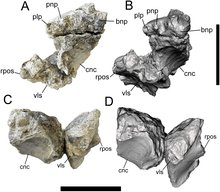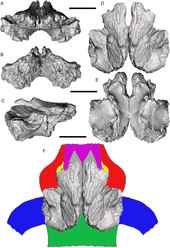Dynamoterror
| Dynamoterror | |
|---|---|
 | |
| Frontal bones in front view | |
| Scientific classification | |
| Kingdom: | Animalia |
| Phylum: | Chordata |
| Clade: | Dinosauria |
| Order: | Saurischia |
| Suborder: | Theropoda |
| Family: | †Tyrannosauridae |
| Subfamily: | †Tyrannosaurinae |
| Genus: | †Dynamoterror McDonald et al., 2018 |
| Type species | |
| †Dynamoterror dynastes McDonald et al., 2018 | |
Dynamoterror is a genus of tyrannosaurid theropod dinosaur that lived in what is now New Mexico during the Late Cretaceous Period, approximately 78 million years ago. The type species is Dynamoterror dynastes. The generic name is derived from the Greek word dynamis (δύναμις) meaning "power" and the Latin word terror. The specific name is derived from δυνάστης, "ruler".[1]
Description

It has been estimated that Dynamoterror would have been about 30 ft (9 m) long.[2] The holotype specimen, UMNH VP 28348, is an incomplete but associated skeleton consisting of cranial and postcranial elements including the left and right frontals, four vertebral centra, fragments of ribs, the right second metacarpal, the ilium, and two phalanx bones of the fourth toe of the left foot.[1]
Discovery

The holotype specimen, UMNH VP 28348, was recovered in the lower Campanian Allison Member of the Menefee Formation in the San Juan Basin of northwestern New Mexico. The remains were first discovered in August 2012 during an expedition led by Andrew McDonald of the Western Science Center and Douglas Wolfe, the CEO of the Zuni Dinosaur Institute for Geosciences. During the expedition, volunteer Eric Gutierrez noticed fragmentary bones present within the sandstone.[2] The specimen is currently housed in the collection of the Natural History Museum of Utah in Salt Lake City, Utah. Fossils of the ammonoid Baculites perplexus known from the same location as UMNH VP 28348 have been dated to between 78.0 and 78.5 million years old, making Dynamoterror approximately 78 million years old.[1] Along with Lythronax, Dynamoterror is one of the oldest tyrannosaurids discovered so far.
Classification
McDonald et al. found Dynamoterror to belong to the Tyrannosaurinae. In their phylogenetic analysis, the genus formed a polytomy with other large bodied derived tyrannosaurines. This polytomy was likely caused by the genus' fragmentary nature.[1]
Below is a cladogram from McDonald et al., 2018.[1]
| Tyrannosauridae |
| ||||||||||||||||||||||||||||||||||||||||||||||||||||||||||||
Paleoecology
Dynamoterror originates from the lower Campanian of the Allison Member of the Menefee Formation, New Mexico.[1] Other fauna known from the formation include the nodosaurid Invictarx, the alligatoroid Brachychampsa sealeyi, and an unnamed centrosaurine ceratopsid.[3][4][5]
See also
References
- 1 2 3 4 5 6 McDonald, A.T.; Wolfe, D.G.; Dooley Jr, A.C. (2018). "A new tyrannosaurid (Dinosauria: Theropoda) from the Upper Cretaceous Menefee Formation of New Mexico". PeerJ: 6:e5749. doi:10.7717/peerj.5749.
- 1 2 Switek, Brian (9 October 2018). "Newly Discovered Tyrant Dinosaur Stalked Ancient New Mexico". Smithsonian. Retrieved 10 October 2018.
- ↑ McDonald, A.T.; Wolfe, D.G. (2018). "A new nodosaurid ankylosaur (Dinosauria: Thyreophora) from the Upper Cretaceous Menefee Formation of New Mexico". PeerJ: 6:e5435. doi:10.7717/peerj.5435.
- ↑ Williamson TE. 1996. Brachychampsa sealeyi, sp. nov., (Crocodylia, Alligatoroidea) from the Upper Cretaceous (lower Campanian) Menefee Formation, northwestern New Mexico. Journal of Vertebrate Paleontology 16(3):421-431.
- ↑ Williamson TE. 1997. A new Late Cretaceous (early Campanian) vertebrate fauna from the Allison Member, Menefee Formation, San Juan Basin, New Mexico. In: Lucas SG, Estep JW, Williamson TE, Morgan GS, eds. New Mexico’s Fossil Record 1. Albuquerque: New Mexico Museum of Natural History and Science Bulletin 11. 51-59.


